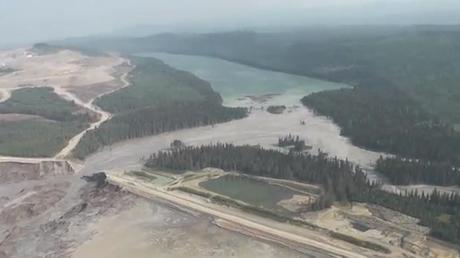
Scene of the Mount Polley mine tailings spill. / YOUTUBE / CRD VIDEO
by Jeff Nagel / The Progress
An estimated 1.5 million migrating Fraser River sockeye salmon are destined for Quesnel Lake, which has now been contaminated by the Mount Polley mine tailings pond spill.
The Quesnel system sockeye make up a major portion of what’s hoped to be a record run this year, according to Craig Orr, executive director of the Watershed Watch Salmon Society.
“This is one of the greatest environmental disasters we’ve had on the Fraser,” Orr said. “Some of the effluent will be getting in the Fraser. The big question is how concentrated, how harmful it will be. Some of these compounds have short term impacts and some have much longer term impacts.”
While the Quesnel Lake stocks are among the Fraser’s most abundant, Orr is particularly concerned that other much weaker stocks that spawn in other tributaries of the Fraser could be harmed.
“People have to be concerned about not just what it means for the returning fish but for the juveniles rearing in the lake right now,” he said. “We don’t know if it’s going to accumulate in their bodies or potentially affect their olfactions, their ability to find their home waters.”
Resident fish at risk include threatened bull trout and plentiful rainbow trout.
The huge spill of tailings effluent tore down Hazeltine Creek, which is where endangered Interior coho salmon are supposed to spawn in a few weeks.
Gord Sterritt, executive director of the Upper Fraser Fisheries Conservation Alliance, said the group, which represents 23 First Nations from Williams Lake to the Fraser’s headwaters, had already raised concerns that planned releases of effluent into the creek by mine operator Imperial Metals might harm the coho.

“Those fish will be holding or just about to enter the spawning grounds pretty quick,” Sterritt said. “We’re pretty concerned about what the toxic elements are going to do those fish. And then there’s the scouring of the debris pile that is potentially going to be moving down the lake and into the river.”
Contamination that reaches the mainstem Fraser could affect fish spawning hundreds of kilometres away, such as in Stuart Lake near Fort St. James.
Sterritt said he’s fielding calls from First Nations as far downstream as Lillooet that are alarmed about the potential impact on their food fisheries.
“People are already talking about not fishing because they don’t know what the toxin levels are going to be in those fish when they ingest them.”
Imperial Metals president Bryan Kynoch described the effluent as “relatively benign.”
He told a news conference Tuesday the effluent nearly meets drinking water standards and the main threat to fish is from the silt, which he said is settling rapidly.
Sto:lo fishery advisor Ernie Crey said there remains widespread concern in aboriginal communities.
“Eventually, this stuff will wend its way into the Fraser,” he said.
Orr noted the spill came just three days after provincial government approval of the new KSM gold mine near the headwaters of the Nass River.
“It’s the same type of mine structure with a lot of tailings placed very close to fish-bearing waters.”
View Larger Map

